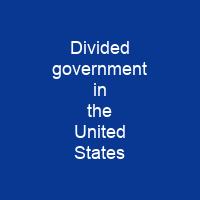Divided government describes a situation in which one party controls the executive branch while another party controls one or both houses of the legislative branch. Those in favor of divided government believe that such separations encourage more policing of those in power by the opposition. Opponents argue that divided governments become lethargic, leading to many gridlocks.
About Divided government in the United States in brief

Opponents, however, argue that divided governments become lethargic, leading to many gridlocks. All newly elected presidents except Zachary Taylor, Richard Nixon, and George H. W. Bush were accompanied by control of one house of Congress.
You want to know more about Divided government in the United States?
This page is based on the article Divided government in the United States published in Wikipedia (as of Jan. 11, 2021) and was automatically summarized using artificial intelligence.







